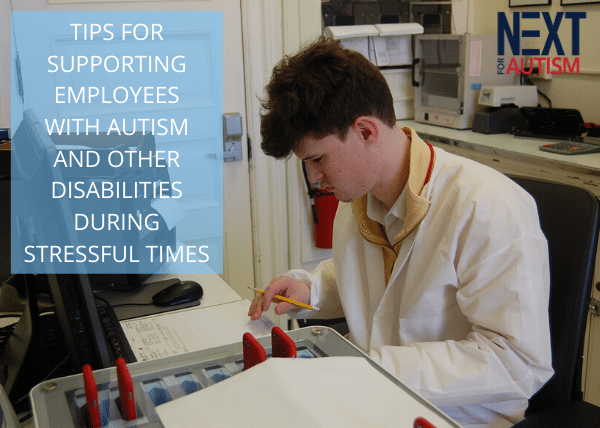For employees who are neurodiverse, the current state of uncertainty can be amplified by their social and communication challenges. NEXT for AUTISM offers these strategies to managers and colleagues, as well as the general public, who can play a role in helping people with special needs during this time.
How to Communicate With Your Employee with Autism and Other Disabilities About Shut-Downs and Other Stressful Events
- Communicate Clearly, Consistently, and Often
- Invest time into making your message concise and direct.
- Be sure to cover these points: Who, What, Where, When (Provide clear time frames), How.
- Allow the opportunity for employees with disabilities to discuss their concerns with you privately.
- During stressful times, the lack of clear and consistent information can lead to anxiety for everyone, particularly for employees with autism and disabilities. Moreover, too much information from too many sources can also be anxiety-provoking. Try to be sensitive to the fact that these employees may feel more vulnerable and adjust your communication style accordingly.
- Make Available Company Policy and Protocols for Remote Work
- Provide a list of the tools and apps that employees need at home
- Ask everyone to test and check their equipment
- Set up buddies or IT professionals to help employees get their virtual tools working
- Provide structure and communicate your expectations clearly:
- Convey the schedule that you expect employees to follow at home. For example: 9-4pm, lunch from 12 -1pm; 15 minute break at 10:30 etc….
- Advise them to follow company dress code and set up a quiet place for video calls
- Encourage them to communicate more than necessary to keep open channels and avoid isolation.
- Employees should answer emails and phone calls promptly, define what promptly means.
- If they have questions, whom should they contact?
How to Support Your Employees with Autism or Special Needs to Work Remotely
- Check in at Least Weekly
- Schedule a team huddle early in the week to set up the team for a successful, productive week.
- Provide ongoing professional support and reassurance during this time. For example, designated office hours when employees can reach you or an open-door policy.
- Set up a regular, personal check in with your team virtually.
- If you have the bandwidth to enquire about personal needs, then we encourage you to do so. Help with planning, scheduling, sharing recipes or tricks for working at home etc...
- Encourage Employees to Manage Anxiety
- Physical activities such as a walk or exercise (with the doctor’s permission)
- Deep breathing exercises to slow down heart rates
- Spending time with family, pets, reaching out to friends, colleagues, and loved ones virtually
- Establish and adhere to a daily schedule








Leave a Reply